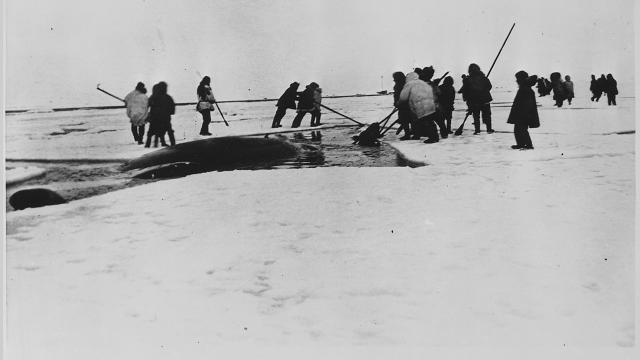Arnold Brower Jr., a 70-year-old Iñupiat whaling captain, can recall his first encounter with scientists clearly. It was 1977, and the International Whaling Commission (IWC) had just placed a moratorium on bowhead whale hunting, after a US government-led population survey determined the marine mammals’ numbers to be dangerously low. But Brower, who has been hunting in the icy Arctic waters surrounding Utqiaġvik (formerly Barrow) since he was a boy, felt certain that conclusion was wrong.
“They told us were are diminishing these whales by taking them, that there were only a few hundred left,” Brower tells me. “We knew there were thousands. We were [treated] like we were lying to them, and we couldn’t take that.”
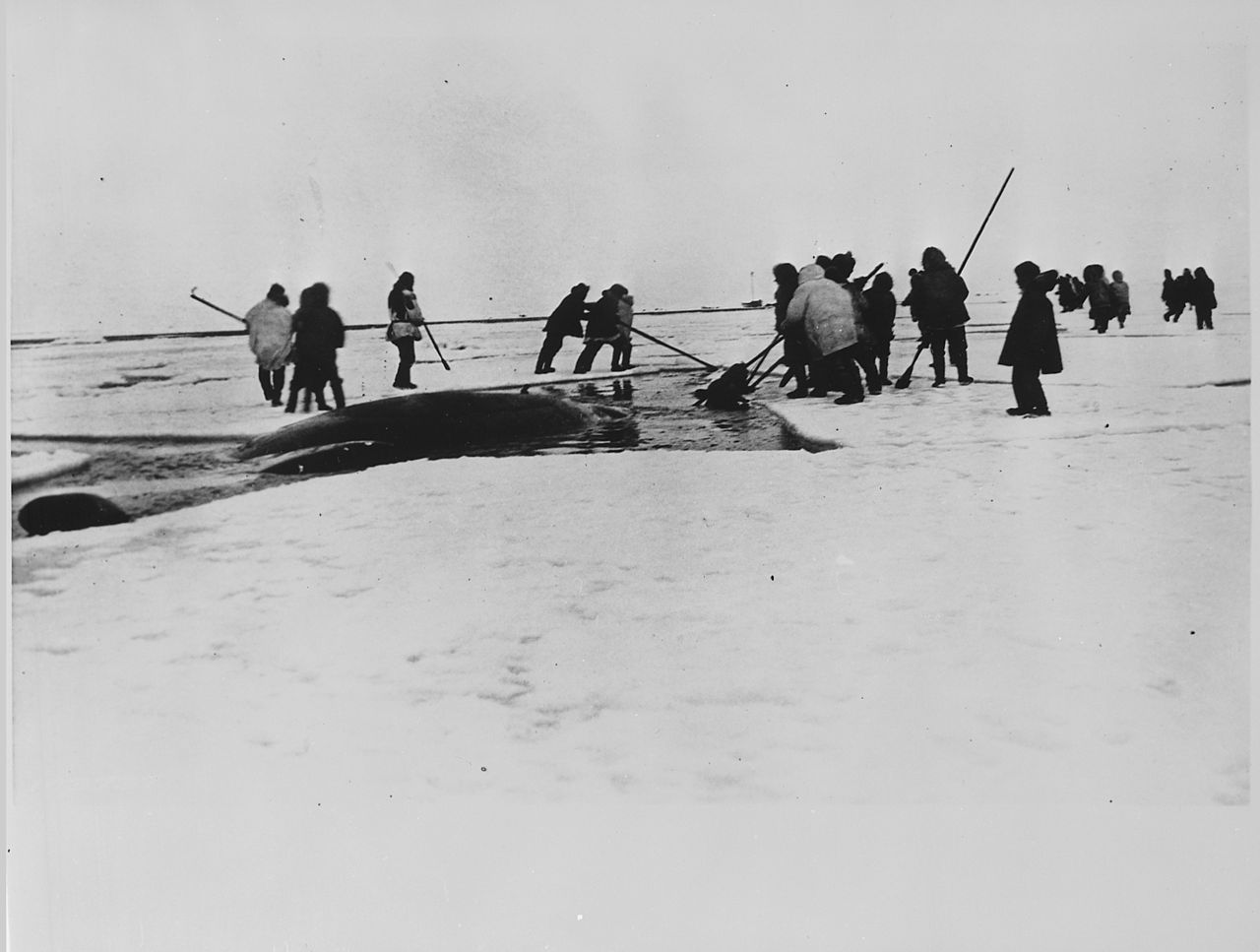
Harpooning a whale, Point Barrow, 1935, U.S. National Archives and Records Administration (Public domain)
And so Brower and his fellow whaling captains decided to take matters in their own hands. They formed the Alaska Eskimo Whaling Commission (AEWC), and partnered with wildlife biologists at the local government of the North Slope Borough to try to improve the population census. Within a few years, the hunters amassed clear evidence that researchers with the National Oceanic Atmospheric Administration had been undercounting bowheads, by overlooking whales that swam hidden beneath sea ice and far offshore. Armed with a revised census, the hunters convinced the IWC to grant them an annual subsistence harvest quota. Over the years, the quota has increased to meet the community’s subsistence needs, and the bowhead whale population has grown in step.
“The people of the North became scientists, and proved to the world there are [thousands of] whales,” Charlie Hopson, a 75-year-old whaling captain with a mischievous twinkle in his eyes, tells me as we chat in AEWC’s headquarters in Utqiaġvik. As Hopson puts it, Iñupiat knowledge prevailed because it was hard-earned, through lifetimes of learning to endure brutally cold winters, where the only food is what can be caught trekking across sea ice platforms atop the Arctic Ocean. “It’s a gorgeous ocean,” he said. “It’s been my classroom, up to today.”
Western science has a long history of dismissing of indigenous knowledge. But in Utqiaġvik, the 4,400-strong Iñupiat community at the northern tip of Alaska’s North Slope, scientists have come to rely on Native experts’ unmatched familiarity with the Arctic environment. Now, some of the same whalers who worked with biologists to revise the bowhead census forty years ago, along with other Native hunters across Alaska, are partnering with researchers to document and interpret the signs of human-caused climate change.
“Local indigenous experts have a very sophisticated understanding of the environment, far more sophisticated than some of us scientists have,” Hajo Eicken, a sea ice researcher who works with indigenous communities across the North Slope and Western Alaska, told me from his office at the University of Alaska, Fairbanks. “But it’s a different form of knowledge.”
Few issues crystallize the difference between academic knowledge and indigenous expertise like climate change, an inescapable reality for the Native Alaskans whose livelihoods depend on the seasonal cycles of ice and animals. Plunging caribou populations linked to rising temperatures and development are threatening the food security of subsistence hunters in Alaska’s interior. Thawing permafrost on Alaska’s North Slope is causing roads and buildings sink and shift, cracking water pipes and sewage lines. Tundra fires are becoming more frequent and severe, posing an unprecedented threat to villages located hundreds of miles from emergency responders.
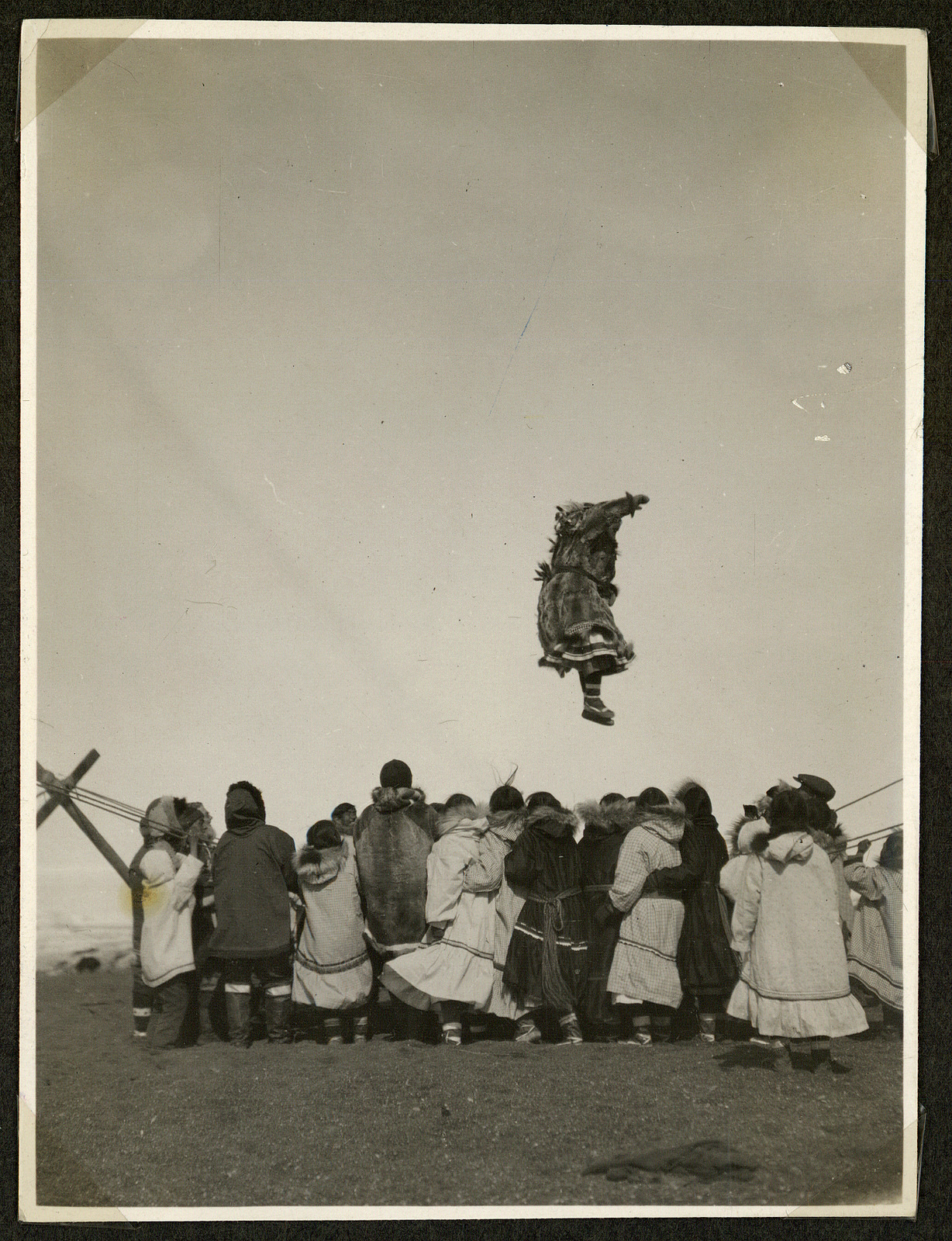
An Inuit woman celebrating the spring whale catch by blanket tossing Point Barrow, Alaska. The woman jumps from an elastic walrus skin held by her fellow celebrators. 1921. Via National Museum of Denmark.
But for Utiaqgvik, and other villages on Alaska’s North Slope, no change is more profound than the recent, dramatic retreat of Arctic sea ice, which Natives use to fish, hunt, and travel between villages. A generation ago, the first “shorefast” ice would form in October, creating miles-wide platforms from land to sea that were stable from early November until mid-July. Now, the shorefast ice firms up later in the fall, and it breaks up weeks earlier in the spring. Even in the dead of winter, the ice is less predictable than it used to be, making it more dangerous to traverse and more difficult to use as a platform for harvesting whales, seals, and walruses.
“It’s kind of insane to me when I see people deny climate change,” Evelyn ‘Aubie’ Gregg, Natural Resources Director at the Iñupiat Community of the Arctic Slope (ICAS), tells me when I visit the tribal government’s headquarters in Utqiaġvik. “We see it on a daily basis.”
Eicken got his first taste of the extensive environmental knowledge possessed by hunters back in 2000, when Native experts and scientists gathered at a symposium in Utqiaġvik to share their observations of changing sea ice conditions. It was the first in a series of community dialogs that would lead to several formal collaborations, including the Sea Ice Zone Observing Network (SIZONet), and more recently, the Alaskan Arctic Observatory and Knowledge Hub (AAOHK). Through these networks, Alaskan Iñupiat and Yup’ik hunters work with researchers at the University of Alaska Fairbanks to record, archive, and disseminate observations of sea ice conditions in searchable online databases, using terms in their Native languages and English. (There are more than 100 terms for sea ice in Kingikmiut, the dialect spoken by the Iñupiat people of Wales, alone.) For researchers who rely mainly on satellite remote sensing data, hunters’ vivid descriptions of conditions on the ground offer invaluable insight into changing weather conditions and ice dynamics.
“[The locals] have provided this whole level of information that we really could not have gotten on our own,” said Olivia Lee, a marine ecologist at the University of Alaska, Fairbanks who started working with Native communities as a post-doctoral researcher in 2013. “They have long term knowledge of what ice conditions are like, and they often would include anecdotal information about how the current ice conditions compared with what they’re familiar with over the long term.”
Lee has been heavily involved with one of the community-oriented products of these collaborations, the Sea Ice for Walrus Outlook (SIWO). A partnership between the National Weather Service, the Eskimo Walrus Commission, and others, SIWO combines local observations with data collected by satellites to issue a weekly springtime weather and ice forecast for villages in northwestern Alaska. These forecasts help hunters decide when when it’s safe to venture onto the ice to catch walruses, a task that is becoming more challenging as nearshore ice breaks up earlier.
“With climate change, it’s getting harder to figure out what the next weather is going to be like, especially during peak hunting periods,” explained Eskimo Walrus Commission director Vera Metcalf. “The ice is becoming less stable — less ideal.” She added that so far, the villages involved in SIWO — Gambell, Savoonga, Wales, Nome, and Shishmaref — have found the collaboration to be “quite valuable.”
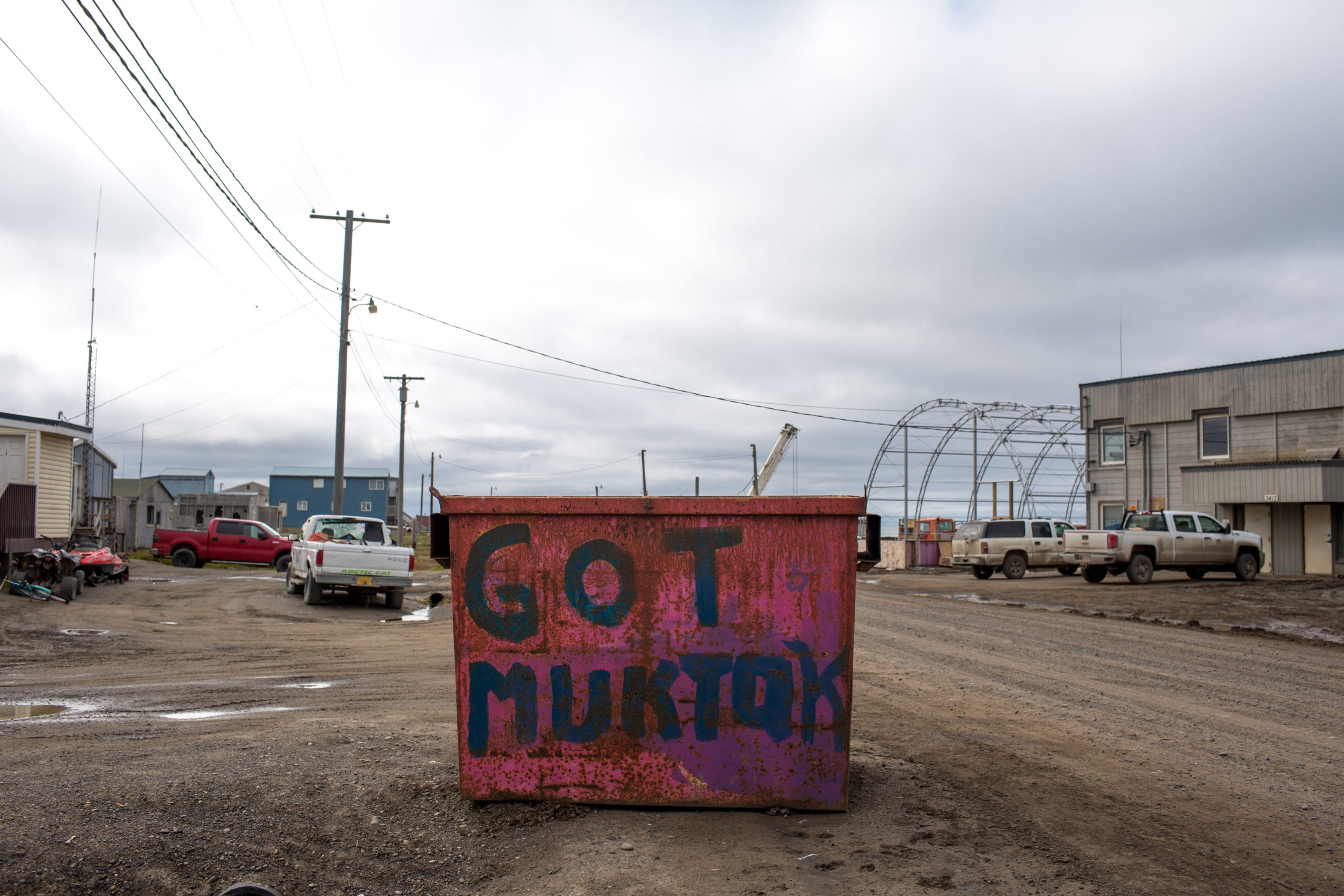
UTQIAGVIK, ALASKA – SUNDAY, SEPTEMBER 20, 2017: A dumpster in Utqiaġvik, Alaska reads “Got Muktak,” which refers to whale blubber. Utqiaġvik is an Inupiat village that subsists off of marine mammals such as whales and seals, which is a practice deeply woven into the culture of the people of the village. Photo: Ash Adams for Gizmodo
“It’s a good practice, the co-production of knowledge that includes indigenous knowledge,” she said.
Lee says her long-term hope is to build a network of hunter/observers who can help biologists keep track of changing marine mammal migration patterns, particularly the migration of grey and bowhead whales, which seem to be travelling north from the Bering to the Chukchi and Beaufort seas earlier in the spring.
“You can sort of track them with acoustic info — but that doesn’t give you the contextual information of whether the animals are accessible to hunters, which has implications for food security,” she said. “And it also won’t tell you about coastal ice conditions. There’s a huge role that communities and their knowledge can contribute.”
“It’s a great way to work,” said Craig George, a wildlife biologist at the North Slope Borough, noting that he and his colleagues have long benefitted from a close relationship with hunters, who allow them access to recently-harvested bowheads for all kinds of anatomical studies. As far as climate change goes, he and the North Slope Borough research team are most concerned about its impact on the body condition of the animals, invasive disease outbreaks, reproduction, and migration patterns. Last year, the team received its very first report of kidney worms in a bowhead from the women among the whaling crews. They speculate that it could be the result of greater interactions with species known to carry these parasites, like humpback whales, but only long-term monitoring and research will tell.
“If there’s anything unusual about an animal, we get a call immediately from the hunters,” he said. “We can develop scientific inquiry around local observations and give something useful back to the communities that rely on these animals.”
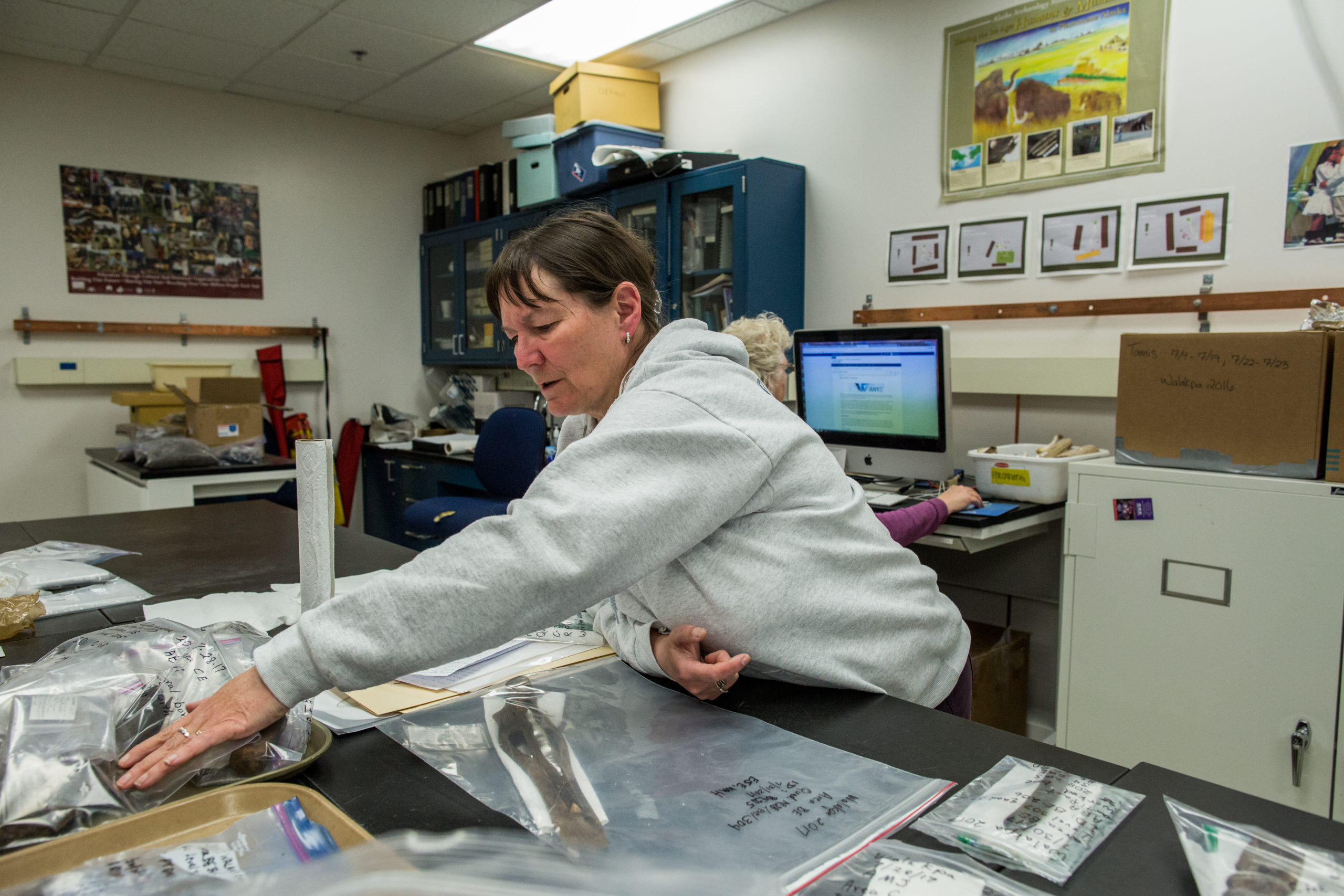
UTQIAGVIK, ALASKA – MONDAY, SEPTEMBER 21, 2017: Anne Jensen, Arctic Anthropologist and Archaeologist with UIC Sciences in Utqiaġvik, looks over some of the artifacts recovered by her team earlier that year at the Walakpa site. Photo: Ash Adams for Gizmodo
Collaborations between scientists and Alaskan Native communities aren’t always so smooth, however. It can takes years for researchers to build rapport with a village, and not all scientists will commit to that level of engagement. In communities that have seen lots of scientists come and go, Lee said, there’s often “a sense of research fatigue, a sense of burnout. They don’t always see what they get back out of it.”
Technological barriers can also create challenges for villages looking to reap the benefits of working with scientists. “It can be hard [to use the SIWO forecasts] because our internet is slow,” Metcalf said. “Downloading satellite photos takes quite a bit of time.” (Other community-oriented products, such as an Inupiat sea ice dictionary co-developed by local experts and researchers in Wales, do not necessarily require a computer.)
Scientists working with indigenous knowledge, meanwhile, struggle with scepticism from the academic community. Many experts perceive local observations to be anecdotal — inferior to data collected in a quantitative study. “It’s an incredible struggle to learn how to use that rich information [from local indigenous experts] when you’re classically trained,” Lee said.
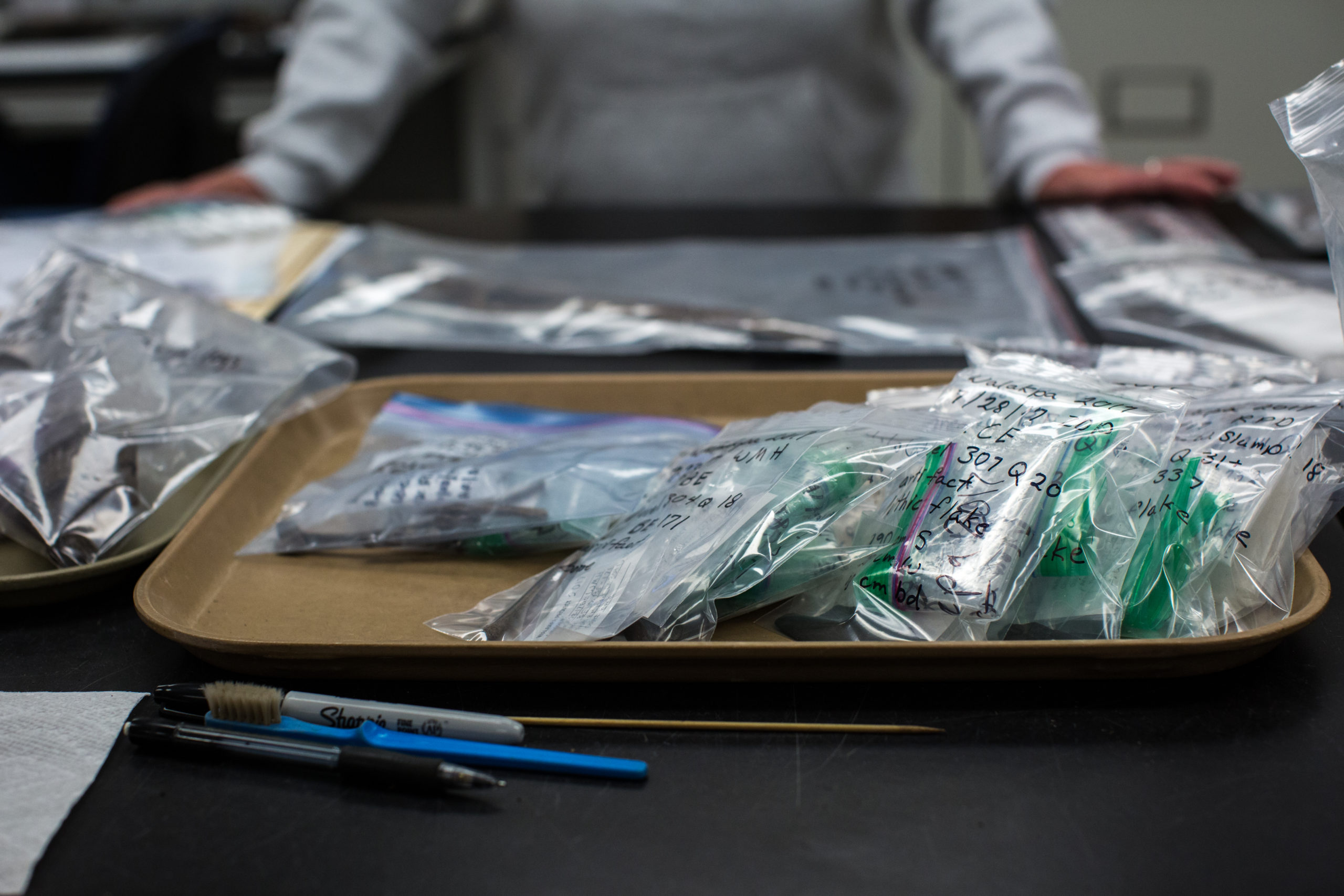
UTQIAGVIK, ALASKA – MONDAY, SEPTEMBER 21, 2017: Anne Jensen, Arctic Anthropologist and Archaeologist with UIC Sciences in Utqiaġvik, looks over some of the artifacts recovered by her team earlier that year at the Walakpa site. Photo: Ash Adams for Gizmodo
Underlying even the most successful collaborations are the scars of colonialism — of forced settlement and forced education, which diluted the traditional identities of many Native Alaskan communities. Some elders, like ICAS president George Edwardson, remember a time when Native Alaskans were deliberately mistreated in the name of science.
A charismatic geologist with long silver hair, Edwardson recalls being administered radioactive iodine tablets a child in the 1950s, as part of a US Air Force experiment that purportedly sought to determine whether the thyroid played a role in Eskimo cold tolerance. Decades later, a National Research Council-led investigation concluded that many Native subjects were not aware they were being asked to consume radioactive material for an experiment that offered no health benefits. “We were lied to,” Edwardson tells me.
“Barrow has a long history of working with scientists, and a lot of people have found that useful,” Anne Jensen, an ethnographic archaeologist of the North Slope based at the Barrow Arctic Science Center a few miles north of town, tells me. “But there have been unfortunate experiences.”
Brower felt recent collaborations with scientists, including the ice observing networks which he has participated in, are to the benefit of hunters — in part, because westerners now take Native expertise more seriously. “Information [from science] has proven traditional knowledge quite accurate,” he said. He’s hoping future studies on the impact of acoustic surveys in the ocean lead to policies that ban such practices in sensitive bowhead habitats — after all, his people have known for generations that too much noise spooks the whales. “It’s bad enough that the ice is receding. Any area that might have detrimental impacts on the species themselves is something that needs critical attention.”
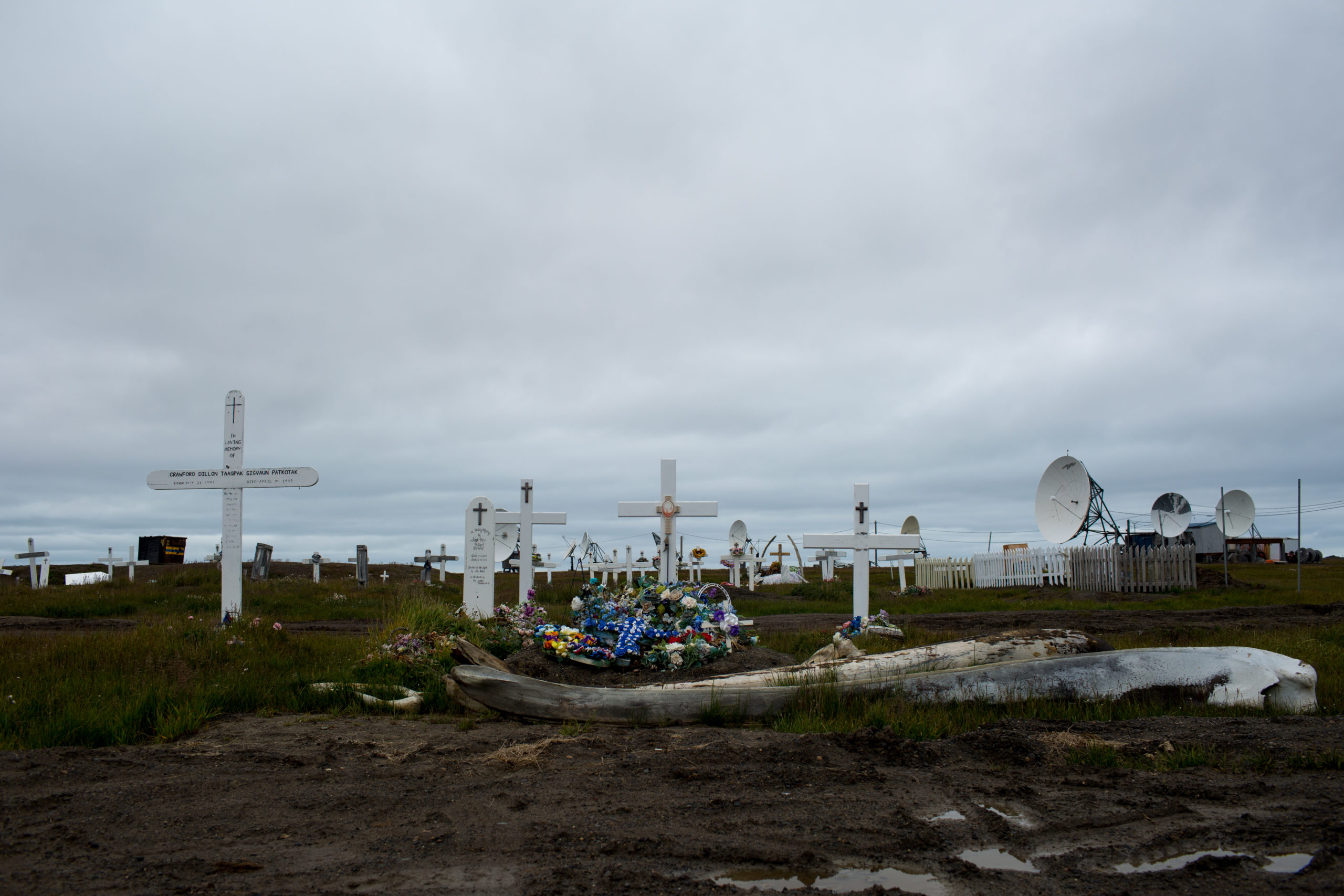
UTQIAGVIK, ALASKA – SUNDAY, SEPTEMBER 20, 2017: The cemetery in Utqiaġvik, Alaska. Photo: Ash Adams for Gizmodo
As for adapting to the challenges climate change will bring, that’s something he’s confident his people will do, with or without the aid of scientists. Hopson expressed a similar sentiment.
“We’ve been making changes and adapting ever since we got here,” Hopson said, noting that hunters are taking advantage of more open water by using bigger boats, and they’re growing accustomed to the whales’ shifting migratory patterns.
Jensen observed that the people of the North Slope have responded to climate changes in the past — not to mention they have managed to survive for millennia in an incredibly challenging environment. “It’s something to be absolutely proud of,” she said.
In her mind, one of the tragedies of human-caused climate change is that it’s causing that long history of adaptation to be lost, as centuries to millennia-old archaeological sites thaw out and erode away faster than they can be excavated and studied. “There is data that will not be there in 10, 20, 30 years,” she said.
But Edwardson was less concerned with physical history being wiped away by the rising seas or the coming storms. “This is your worry,” he emphasised when I brought up climate change. For Iñupiat culture to live on, he said, his people must continue to pass memories and knowledge down from generation to generation, the way they always have. “This is how, without writing, our stories continue, how we can go through Ice ages surviving right here.”
“I’m gonna have to change my hunting habits and go to certain places,” that I didn’t go before, he said. “But I will survive.” Later, walking along Uqtiaqgvik’s desolate, salt-scented shoreline, I realised that when he said “I,” he meant “we.”
This article was made with funding from Participant Media, the creator of “An Inconvenient Sequel: Truth to Power.”
